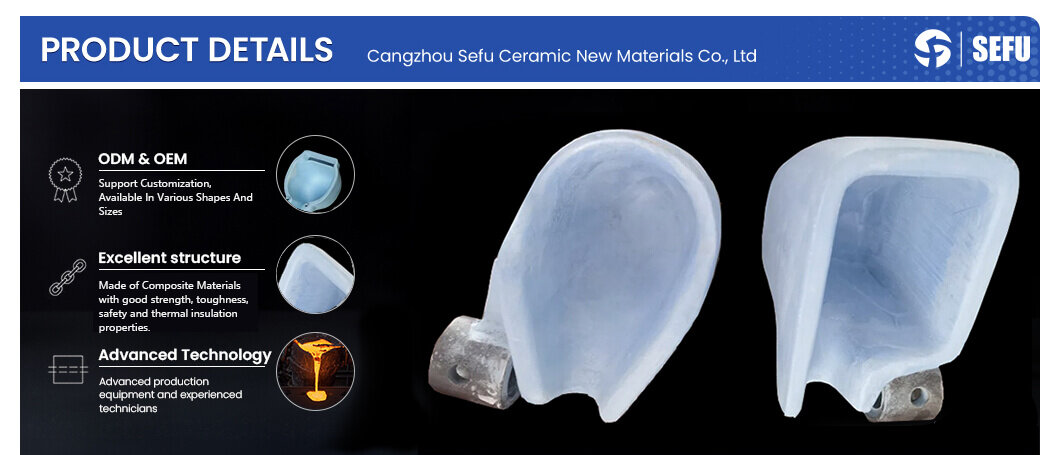On the aluminum casting production line, a seemingly simple tool – the pouring spoon, plays a decisive role in the final product quality and production efficiency. Traditional iron pouring spoons are gradually being replaced by a new generation of ceramic fiber composite pouring spoons. This technological innovation is reshaping the production standards of the casting industry.
Material Revolution: From Metal to Ceramic
Traditional iron pouring spoons have many inherent defects: heavy weight leads to operating fatigue, poor thermal insulation performance causes energy waste, and iron pollution affects the purity of aluminum liquid. The birth of ceramic fiber composite pouring spoons perfectly solves these problems. This special material composed of calcium oxide, aluminum oxide and silicon dioxide forms a unique microstructure through advanced preparation technology, making its density reach 1600kg/m³ while the thermal conductivity is only 0.43W/(m·K).
Even more commendable is its excellent mechanical properties, with a rupture modulus of up to 21.4Mpa, which is enough to withstand repeated flushing of aluminum liquid. The thermal expansion coefficient of the material is only 0.9×10⁻⁶mm/mm/℃, which gives the product excellent thermal shock resistance and completely solves the problem of easy cracking of traditional refractory materials.
Breakthrough surface treatment technology of Ceramic Pouring Spoon
The boron nitride (BN) coating on the surface of the ceramic pouring spoon is the key to its “non-stick aluminum” property. The contact angle between this coating and the aluminum liquid is greater than 90°, forming an effective physical barrier. When the blue BN coating gradually turns white due to use, a simple re-spraying can restore its protective properties. This design allows the service life of the ceramic pouring spoon to reach 30,000-60,000 castings, which is 5-8 times that of traditional products.
Intelligent use experience
The use of ceramic pouring spoons embodies the “people-oriented” design concept:
- Ready-to-use design: no preheating is required to put it into production, eliminating the hours of preheating time for traditional pouring spoons
- Lightweight structure: 3-10mm thin-wall design makes operation easier
- Intelligent temperature control: can withstand 780℃ aluminum liquid temperature, but the recommended working temperature does not exceed 850℃
Maintenance is also extremely simple, just pay attention to:
- Use dry compressed air for cleaning (humidity must be less than 5%)
- Avoid direct baking with high-temperature torches
- Check the coating status regularly
Synergy effect of matching flow channel system
The U/V-type flow channel matched with the ceramic pouring spoon also uses ceramic fiber composite materials, which solves many pain points of traditional cast iron flow channels:
- Eliminate the “incomplete pouring” phenomenon
- Reduce the cleaning time by 20 minutes/time
- No need for continuous heating
- Reduce aluminum liquid disturbance by more than 30%
Actual application value of Ceramic Pouring Spoon
After a certain automotive parts manufacturer adopted the ceramic pouring spoon system, the production efficiency increased by 25%, the product porosity decreased by 40%, and the energy cost was saved by about 150,000 yuan per year. What is more worth mentioning is that due to the avoidance of iron pollution, the casting yield rate has increased from 92% to 98.5%.
Future Outlook
With the advancement of materials science, the third-generation ceramic pouring spoon is under development. It is expected to adopt gradient functional material design to increase the temperature resistance to 900℃ and the service life to more than 100,000 castings. The intelligent pouring spoon system will also integrate temperature sensors and flow monitoring to achieve digital control of the casting process.
The ceramic pouring spoon is not only a tool innovation, but also represents the transformation of the casting process towards high efficiency, energy saving and environmental protection. Its wide application is redefining the quality standards and production efficiency of the aluminum casting industry, and providing new technical support for the high-quality development of the manufacturing industry.



